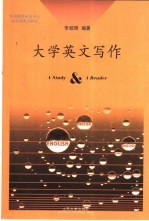图书介绍
大学英文写作pdf电子书版本下载

- 李绍明编著 著
- 出版社: 济南:山东大学出版社
- ISBN:7560720951
- 出版时间:2002
- 标注页数:534页
- 文件大小:13MB
- 文件页数:547页
- 主题词:
PDF下载
下载说明
大学英文写作PDF格式电子书版下载
下载的文件为RAR压缩包。需要使用解压软件进行解压得到PDF格式图书。建议使用BT下载工具Free Download Manager进行下载,简称FDM(免费,没有广告,支持多平台)。本站资源全部打包为BT种子。所以需要使用专业的BT下载软件进行下载。如 BitComet qBittorrent uTorrent等BT下载工具。迅雷目前由于本站不是热门资源。不推荐使用!后期资源热门了。安装了迅雷也可以迅雷进行下载!
(文件页数 要大于 标注页数,上中下等多册电子书除外)
注意:本站所有压缩包均有解压码: 点击下载压缩包解压工具
图书目录
Part One THE STUDY 3
Chapter 1 3
Why learning English writing 3
1.1 Why learning to write 3
1.2 Why learning English writing 5
Chapter 2 9
How we write in today s China 9
2.1 Words and empty words: The writing of our press 10
2.2 A matter of taste 21
2.3 How we write about books 27
2.4 How we write about literature 29
2.5 Attitude toward people 33
2.6 Reform from the one-phrase writing 36
2.7 More about the one-phrase writing: Captions and titles 41
Chapter 3 54
Different writings: The National Geographic way and the China Pictorial way 54
3.1 Selection One with comments 55
3.2 Selection Two with comments 58
3.3 Selection Three with comments 60
3.4 Selection Four: More poor writings 61
3.5 Less than poor writing: Selection Five with comments 68
3.6 Selection Six: Articles about activity 73
3.7 Selection Seven: More about activity 75
3.8 Selection Eight: A comparison 78
3.9 Selection Nine: Articles about living things 79
3.10 Selection Ten: How to make the claim 81
3.11 Selection Eleven: Stand concerned 86
Chapter 4 90
Our English learners problems 90
4.1 Problems with the infinitive 91
4.2 Other grammatical problems 94
4.3 Misuse of words 97
4.4 Redundancy and wordiness 102
4.5 Chinglish 105
4.6 Problems at higher levels 111
Chapter 5 118
Be a critical thinker 118
5.1 Understand ourselves 118
5.2 Be critical to information 124
5.3 The arbitrary language 128
5.4 The uses of language 131
5.5 The uses of language(continued) 138
5.6 Propaganda 150
5.7 How to go wrong 156
6.1 Types of writing 173
Chapter 6 173
Types of writing 173
6.2 Types as strategies for development 177
Chapter 7 191
From paragraph to essay 191
7.1 The paragraph 191
7.2 The essay 197
Chapter 8 201
The Writing process 201
8.1 The overall picture 201
8.2 From subject to thesis 208
9.1 Writing correctly and writing well 214
Chapter 9 214
Grammar and writing well 214
9.2 Exploiting the English grammar 215
9.3 English well used 222
APPENDIX 241
Mechanics of English composition 241
Part Two THE READER 259
1.How to Write Clearly,by Edward T.Thompson 259
2.Clear Writing Means Clear Thinking Means...by Marvin H.Swift 265
3.How to Say Nothing in 500 Words,by Paul Roberts 275
4.What the Jury Should Know,from the Washington Post 294
5.Is the Earth Round or Flat?by Alan Lightman 297
6.Evolution as Fact and Theory,by Stephen Jay Gould 303
7.Creation Versus Evolution,by Gish and Asimov 314
8.Learning to Name,by Helen Keller 330
9.Learning to Name,by Anne Sullivan 332
10.The Taken-for-grantedness of Language,by Hayadawa,S.I. 334
11.The Story of A-Town and B-ville: A Semantic Parable,by Hayakawa,S.I. 339
12.Styles of Communication and Thinking in the Classroom,by Douglas Barnes 347
13.Propaganda Techniques in Today s Advertising,by Ann McClintock 356
14.Advertising Claims,by Jeffrey Schrank 367
15.It s Natural!It s Organic!Or Is It?by the Editors of Consumer Reports 378
16.Like Too Bad,Yeah,by Tom Wicker 389
17.Weasel Words,by Paul Stevens 393
18.Politics and the English Language,by George Orwell 411
19.The Promise of Sociology,by C.Wright Mills 431
20.The Realities of Power?by Arnold K.Sherman and Aliza Kolker 442
21.How It Feels To Be Out of Work,by Jan Halvorsen 470
22.Jobs and Work,by Paul L.Wachtel 475
23.TV Addiction,by Marie Winn 486
24.Television and Reading,by Marie Winn 491
25.The Politics of Reading,by Neil Postman 504
26.Critical Thinking and Obedience to Authority,by John Sabini and Maury Silver 518